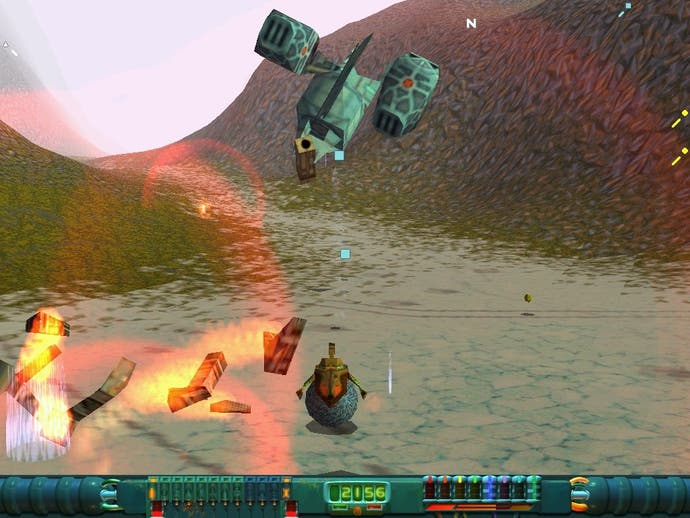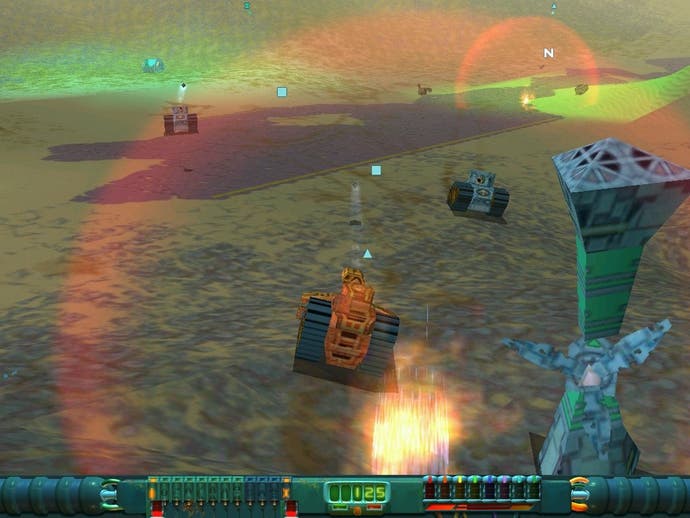Retrospective: Wild Metal Country
Rockstar juvenilia.
Once this insight has been gained, and the eager tanker begins concentrating on tactics rather than coordination, the game unfurls like a tide-covered sea anemone. Though every mission has the same simple premise (scour lumpy moon for 8 coloured pods then collect those pods in the teeth of fierce enemy resistance) the limitless combinations of topography, foes and weaponry mean no two engagements are ever the same. Every time you scramble onto a ridge and find yourself gazing down at a pod site teeming with tracked and aerial enemies, gun towers, shield walls and mine throwers, a new bespoke plan must be hatched.
Feeling cautious? Take your time, scout the locale for good firing positions and escape routes, before methodically pounding static targets and luring out mobile ones. Feeling daring? How about a spot of daylight robbery. Dart in at breakneck speed, knock the pod from its shielded enclosure with a couple of well-aimed snap-shots, then pounce on it and flee with shells bursting all around you.
Very occasionally, unfettered aggression will do the trick. The times when you hurtle into the heart of the hornets' nest, ramming tanks, scattering mines, and plucking gunships from the sky with perfectly angled arcs of bullet fire, are particularly sweet. This is a game where the more skilful you get, the more fun you have. Somehow it also manages to be a game where confidence never brings complacency.
However adept you are at dodging Bouncing Betty mines (think kamikaze grasshoppers) or pirouetting round hover tanks on a frozen lake, one moment of inattention or clumsiness in the presence of any enemy trundler can be fatal. Even the ablest armourists will find themselves running for their lives at times, a nervous finger poised over the beacon button.

Jettisoning a beacon just before a fiery demise makes finding the pods and weapon packs that spill from wracked tanks that bit easier post-respawn. You see, there's no map in Wild Metal Country. The lack of convenient cartography was probably another reason why the game attracted such mixed reviews. The fact that the intense firefights are sandwiched between longish periods of exploration doubtless rubbed a few reviewers up the wrong way. For me the orienteering is one of the pleasures of play.
As I scoot up hills and down dales, pod directions seared into my memory (scattered teleport stations provide pod azimuths) I'm constantly pathfinding - scouring ridges for potential routes and viewpoints. The gritty physics mean some slopes can only be scaled at speed, or in a particular tank type. One of Wild Metal Country's most agonizing and distinctive experiences is to scurry up a peak with enemies in hot pursuit and realise too late that you don't have the momentum to make the top.
Occasionally an incoming shell will shove you the last few yards, but usually there's no option but to jam a track into reverse, perform a nervy spin and power back down the hill, hopefully avoiding your surprised chasers.
Short of flora and texture variety they may be, but those hills are loaded with tactical significance. Terrain is as big a part of the play experience as, say, the sly, unpredictable enemies. Whether blizzard-blasted tundra, pyramid-dotted dunes, or misty Lake District-style fells, the humps and hollows are there to be read and utilized. A valley shoulder will tighten a turn, a gully will funnel barrel mines, a shallow fold will shield you from bouncing munitions.

If DMA had allowed us to dent the terrain with weaponry, the action would, I suspect, have been even more compelling. As you ramble about, constantly watching for the tell-tale Christmas-light glow of pods, there's ample opportunity to contemplate the sequel that never was. As much as I enjoy the instinctive gunnery and uncluttered display, I think I'd have lobbied for some form of crosshairs or trajectory indicator in the follow-up. Such a feature could have been optional, difficulty-level linked, or - like the scanner - jammable by certain enemies. It certainly would make those early hours in the field a bit less alarming.
It's tempting to imagine the game with a 1st person perspective too. If the camera was a game object - a destroyable aerial drone - then a tense ground-level view could be a temporary penalty - a mood-altering consequence of battle damage or carelessness.
There's also huge potential for enrichment in the realm of background blather. Wild Metal Country is a creation without narrative or characters. There's no cutscenes, no text briefings, no static-distorted comms pop-ups. It's almost as if the Dundee dev ran out of money or time. After years of play I still have no real idea why I'm spending hour after hour gathering those pretty pods.
Actually that's not quite true. I'm doing it because it's Bloody Good Fun. Don't believe me? Rockstar's splendid generosity means you can form your own conclusions for free.